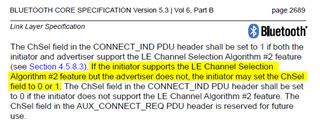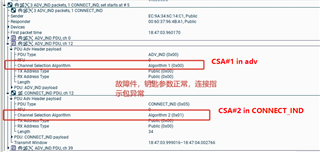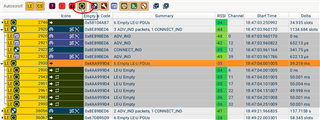Tool/software:
My customer found that their central device(NXP KW45) still sends CONNECT_IND with CSA#2 when CSA#2 is already disabled on peripheral side(CC2642).
In BLE core spec 5.3, there are two sections which look contradictory about CSA#2. In Vol 6, Part B, 2.3.3.1 it says that the initiator may set the ChSel field to 0 or 1 in case of the initiator supports CSA#2 but the advertiser does not:

While in Vol 6, Part B, 4.5 it says when either or both PDU had ChSel = 0, CSA#1 shall be used:

Which one is correct? Is it legal for the central device to use CSA#2 when it is not supported by peripheral?
Best regards,
Shuyang






